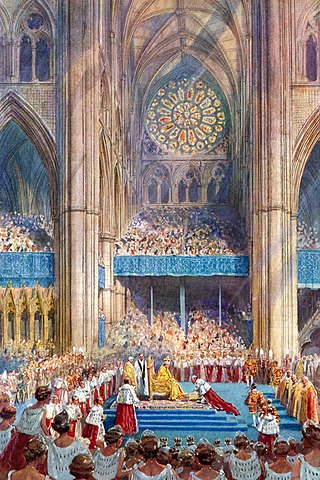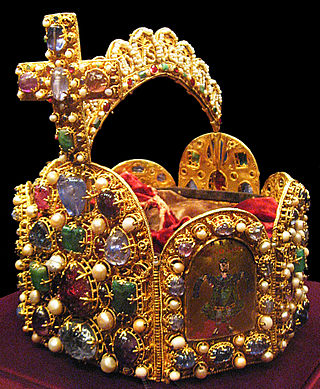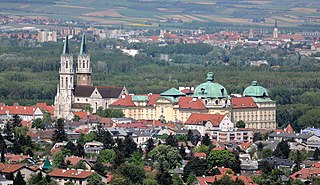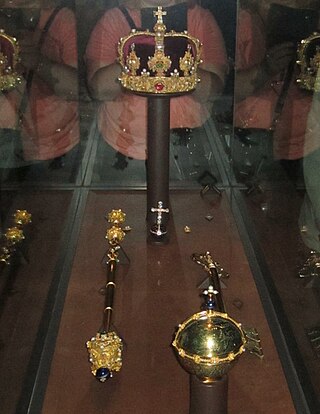

The archducal hat of Joseph II is an imperial insignia of Joseph II, Holy Roman Emperor.


The archducal hat of Joseph II is an imperial insignia of Joseph II, Holy Roman Emperor.
The Habsburg dynasty used the archducal hat on several occasions, such as the homage paid by the estates. Since the 16th century, it was worn as a sign of their rank as archdukes of Austria in the procession prior to the Imperial coronation at Frankfurt am Main. Since the custodians of the archducal hat at Klosterneuburg Monastery refused to allow the archducal hat to be used by Joseph II for the procession preceding his coronation at Frankfurt am Main in 1764, a new archducal coronet had to be created.
This new coronet did not follow the pattern of the hat in Klosterneuburg. It consisted of a golden eastern coronet with pearls and precious stones. A flat velvet cap encircled by ermine was included. Having only one arch, it resembled the original archducal coronet introduced by Rudolph IV of Austria. At the center of the arch, it is surmounted by a globe and cross.
After the coronation, the coronet became obsolete. The jewels and pearls were removed and were used for other purposes. Its frame, however, survived and can be seen in the Imperial Treasury, Vienna. Its original state can be seen in a contemporary painting of Joseph II. [1]

Crown jewels are the objects of metalwork and jewellery in the regalia of a current or former monarchy. They are often used for the coronation of a monarch and a few other ceremonial occasions. A monarch may often be shown wearing them in portraits, as they symbolize the power and continuity of the monarchy. Additions to them may be made, but, since medieval times, the existing items have been typically passed down unchanged, symbolizing the continuity of a monarchy.

A crown is a traditional form of head adornment, or hat, worn by monarchs as a symbol of their power and dignity. A crown is often, by extension, a symbol of the monarch's government or items endorsed by it. The word itself is used, particularly in Commonwealth countries, as an abstract name for the monarchy itself as distinct from the individual who inhabits it. A specific type of crown is employed in heraldry under strict rules. Indeed, some monarchies never had a physical crown, just a heraldic representation, as in the constitutional kingdom of Belgium.

The Crown Jewels of the United Kingdom, originally the Crown Jewels of England, are a collection of royal ceremonial objects kept in the Jewel House at the Tower of London, which include the coronation regalia and vestments worn by British monarchs.

The coronation of the monarch of the United Kingdom is an initiation ceremony in which they are formally invested with regalia and crowned at Westminster Abbey. It corresponds to the coronations that formerly took place in other European monarchies, which have all abandoned coronations in favour of inauguration or enthronement ceremonies. A coronation is a symbolic formality and does not signify the official beginning of the monarch's reign; de jure and de facto his or her reign commences from the moment of the preceding monarch's death or abdication, maintaining legal continuity of the monarchy.

In British heraldry, a coronet is any crown whose bearer is less than sovereign or royal in rank, irrespective of the crown's appearance. In other languages, this distinction is not made, and usually the same word for crown is used irrespective of rank In this use, the English coronet is a purely technical term for all heraldic images of crowns not used by a sovereign, and implies nothing about the actual shape of the crown depicted. A Coronet is another type of crown, but is reserved for the lower ranks of nobility like Marquesses and Marchionesses, Earls and Countesses, Barons and Baronesses, and some Lords and Ladies. The specific design and attributes of the crown or coronet signifies the hierarchy and ranking of its owner.

Archduke was the title borne from 1358 by the Habsburg rulers of the Archduchy of Austria, and later by all senior members of that dynasty. It denotes a rank within the former Holy Roman Empire (962–1806), which was below that of Emperor, and roughly equal to King, Prince-Archbishop, and Grand prince, but above that of a Grand Duke, Sovereign Prince, and Duke.

The Imperial Crown of the Holy Roman Empire, a hoop crown (Bügelkrone) with a characteristic octagonal shape, was the coronation crown of the Holy Roman Emperor, probably from the late 10th century until the dissolution of the Holy Roman Empire in 1806. The crown was used in the coronation of the King of the Romans, the title assumed by the Emperor-elect immediately after his election. It is now kept in the Imperial Treasury at the Hofburg in Vienna, Austria.

Leopold III, known as Leopold the Good, was the Margrave of Austria from 1095 to his death in 1136. He was a member of the House of Babenberg. He was canonized on 6 January 1485 and became the patron saint of Austria, Lower Austria, Upper Austria and Vienna. His feast day is 15 November.

The Austrian Crown Jewels are the regalia and vestments worn by the Holy Roman Emperor, and later by the Emperor of Austria, during the coronation ceremony and other state functions. The term refers to the following objects: the crowns, sceptres, orbs, swords, rings, crosses, holy relics and royal robes, as well as several other objects connected with the ceremony. The collection dates from the 10th to the 19th centuries, and it reflects more than a thousand years of European history. It is kept in the Imperial Treasury at the Hofburg Palace in Vienna, Austria.

The archducal hat is the insignia of the Archduchy of Austria and is kept in the treasury of Klosterneuburg Monastery. It appears in heraldry such as the state coat of arms of Upper Austria.

An imperial crown is a crown worn by an emperor. In the European cultural area, it also symbolizes the power of the empire in heraldic depictions. The craftsmanship corresponded to the king's crown, with precious stones and pearls set into the precious metal frame for decoration. Their external form differed from crowns of the same period and the same reign. The use of Christian symbols to emphasize the divine rule of the emperor is the reason for the deviation.

The Imperial Crown of Austria is a crown formerly in use by the monarchs of the Habsburg monarchy. The crown was originally made in 1602 in Prague by Jan Vermeyen as the personal crown of Holy Roman Emperor Rudolf II, and therefore is also known as the Crown of Emperor Rudolf II. The crown was used as a private crown of the Holy Roman Emperors and Kings of Hungary and Bohemia from the House of Habsburg. In 1804 it became the official crown of the newly constituted Austrian Empire. After 1867 it remained the imperial crown of the Cisleithanian part of the Austro-Hungarian Empire until 1918.

Typical of British heraldry, a cap of maintenance, known in heraldic language as a chapeau gules turned up ermine, is a ceremonial cap of crimson velvet lined with ermine, which is worn or carried by certain persons as a sign of nobility or special honour. It is worn with the high part to the fore, and the tapering tail behind. It may substitute for the torse in the heraldic achievement of a person of special honour granted the privilege by the monarch. It thus appears in such cases on top of the helm and below the crest. It does not, however, feature in the present royal coat of arms of the United Kingdom, which shows the royal crest upon the royal crown, itself upon the royal helmet.

Klosterneuburg Abbey is a twelfth-century Augustinian monastery of the Catholic Church located in the town of Klosterneuburg in Lower Austria. Overlooking the Danube, just north of the Vienna city limits at the Leopoldsberg, the monastery was founded in 1114 by Saint Leopold III of Babenberg, the patron saint of Austria, and his second wife Agnes of Germany.

A crown is often an emblem of a sovereign state, usually a monarchy, but also used by some republics.

Frankfurt Cathedral, officially Imperial Dome of Saint Bartholomew, is a Roman Catholic Gothic church located in the heart of Frankfurt am Main, Germany. It is dedicated to Saint Bartholomew.

Sweden's regalia are kept deep in the vaults of the Royal Treasury, underneath the Royal Palace in Stockholm, in a museum that is open to the public. The crowns and coronets have not been worn by Swedish royalty since 1907, but they are still displayed at weddings, christenings and funerals.

The Holy Roman Emperor received the imperial regalia from the hands of the Pope, symbolizing both the pope's right to crown Christian sovereigns and also the emperor's role as protector of the Catholic Church. The Holy Roman empresses were crowned as well.

The archducal hat of Tyrol is an insignia of the County of Tyrol. It is located in the treasury of Mariastein.

Coronations were previously held in the monarchies of Europe. The United Kingdom is the only monarchy in Europe that still practises coronations. Other European monarchies either have replaced coronations with simpler ceremonies to mark an accession or have never practised them. Most monarchies today only require a simple oath to be taken in the presence of the country's legislature.